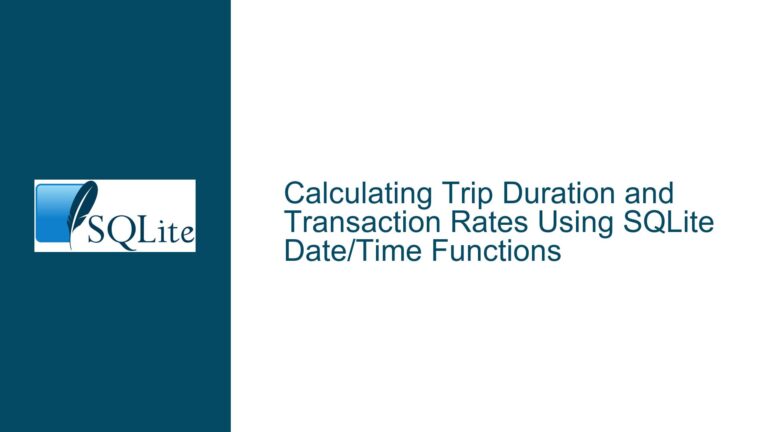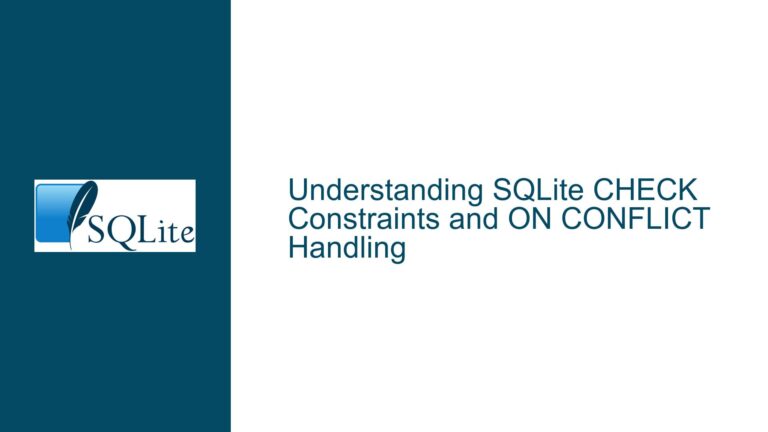Handling SQLite Parameter Limits and Escaping NULL Characters in Dynamic Queries
Issue Overview: Parameter Limits, NULL Character Escaping, and Dynamic Query Generation in SQLite
When working with SQLite, developers often encounter the host parameter limit (defaulting to 999, configurable up to 32766). This constraint becomes critical when generating IN clauses with large lists of values. A common workaround involves replacing parameter placeholders with literal values directly embedded in SQL queries. However, this approach introduces two major challenges:
- SQL Injection Risks: Embedding unescaped user-supplied values exposes applications to injection attacks.
- NULL Character Handling: SQLite’s
quote()function truncates strings at the first NUL (ASCII 0) byte, creating data integrity vulnerabilities.
The problem intensifies in Android environments where Java/Kotlin libraries abstract SQLite operations. Developers must implement value escaping while handling binary data containing NUL bytes and maintaining query performance. Secondary concerns include SQL function compatibility (e.g., json_each), BLOB vs TEXT storage semantics, and query planner behavior with large literal lists.
Possible Causes: Parameter Expansion Limits, String Termination Conventions, and Type Handling
1. SQLite’s Host Parameter Limitations
SQLite enforces a maximum number of host parameters per prepared statement to prevent excessive memory consumption. When translating list parameters like :ids into (?,?,...) placeholders, large lists exceed this limit. This forces developers to choose between:
- Chunking operations (multiple queries)
- Dynamic query generation with literal values
- Alternative parameter passing mechanisms
2. NUL Byte Handling in String Functions
SQLite’s TEXT type allows embedded NUL characters, but many string functions (e.g., length(), substr()) treat NUL as a terminator due to compatibility with C-style strings. The quote() function uses this convention, making it unsafe for binary data or strings containing 0x00 bytes.
3. Type-Specific Escaping Requirements
Different data types require distinct escaping rules:
- TEXT: Requires single-quote wrapping and single-quote doubling
- BLOB: Uses hexadecimal literals with
x'...'syntax - NUMERIC: Safe for direct embedding (with exceptions for non-numeric characters)
- NULL: Requires
IS NULLcomparisons instead of equality
Mixing these types in dynamically generated queries without proper type tracking leads to syntax errors or data corruption.
Troubleshooting Steps, Solutions & Fixes: Escaping Strategies, JSON Unnesting, and BLOB Conversion
1. Secure Value Escaping Implementation
For TEXT Values Containing NULs:
Implement a custom escaping function that:
- Wraps strings in single quotes
- Replaces single quotes (
') with doubled quotes ('') - Handles NUL bytes by processing the entire string length rather than stopping at 0x00
Java/Kotlin Example:
fun escapeText(value: String): String {
val escaped = value.replace("'", "''")
return "'$escaped'"
}
// For byte arrays with potential NULs:
fun escapeBlob(bytes: ByteArray): String {
val hex = bytes.joinToString("") { "%02x".format(it) }
return "x'$hex'"
}
For BLOB Conversion:
Store binary data as BLOBs using hexadecimal notation. This avoids NUL issues entirely but requires schema changes and data type consistency:
SELECT * FROM files WHERE content = x'01234abc00def';
Parameter Validation:
- Reject values containing unescaped quotes or unbalanced hex digits
- Use whitelists for allowed characters in text fields
- Validate numeric types with regex before embedding
2. JSON-Based Parameter Reduction
Use SQLite’s JSON1 extension to pass large lists as a single JSON array parameter, then unpack with json_each:
Query Transformation:
Original:
SELECT * FROM users WHERE id IN (:ids)
Modified:
SELECT * FROM users WHERE id IN (
SELECT value FROM json_each(:json_array)
)
Implementation Steps:
- Convert the ID list to a JSON array in application code:
val jsonArray = "[${ids.joinToString(",")}]" - Bind
jsonArrayas a single parameter to:json_array
Advantages:
- Avoids parameter limit by using one host parameter
- Maintains prepared statement safety
- Handles all scalar types (integers, strings, nulls)
Caveats:
- Requires SQLite 3.38.0+ for full JSON5 support
- JSON parsing adds overhead for very large arrays (>10k elements)
- Index usage may be affected; verify with
EXPLAIN QUERY PLAN
3. carray Extension for Bound Arrays
The carray extension allows binding arrays as parameters without dynamic SQL:
Query Syntax:
SELECT * FROM users WHERE id IN carray(?);
Implementation:
- Load
carrayextension in SQLite (not available on Android by default) - Bind array as a parameter using a specialized method
Limitations:
- Android compatibility uncertain due to extension loading restrictions
- Requires separate handling for different data types (intarray, textarray)
- Doesn’t resolve NUL-byte issues in text values
4. Chunked Query Execution
When other methods aren’t feasible, split large lists into multiple queries:
Algorithm:
- Calculate maximum allowable parameters per chunk (
max_params = 999 - existing_params) - Split ID list into chunks of
max_params - Execute chunked queries:
SELECT * FROM users WHERE id IN (?,?,...) UNION ALL SELECT * FROM users WHERE id IN (?,?,...)
Optimizations:
- Use
UNION ALLinstead of OR for better index utilization - Cache prepared statements for each chunk size
- Balance chunk size between parameter count and query count
5. Schema and Query Redesign
Re-architect data models to avoid large IN clauses:
Temporary Join Tables:
- Create temp table
search_ids(id PRIMARY KEY) - Insert target IDs using batch inserts
- Join with main table:
SELECT users.* FROM users INNER JOIN search_ids ON users.id = search_ids.id
Materialized Views:
Precompute frequently queried subsets:
CREATE VIEW active_users AS
SELECT * FROM users WHERE active = 1;
6. SQLite Configuration Adjustments
Increase the parameter limit temporarily during bulk operations:
// C API example (not directly applicable to Java/Kotlin)
sqlite3_limit(db, SQLITE_LIMIT_VARIABLE_NUMBER, 32766);
Android Considerations:
- SQLite limits are set per-connection
- Not all Android SDK versions allow modifying limits
- Prioritize stable parameter counts over maximum performance
7. Comprehensive Type Handling Framework
Implement a type-aware escaping layer that:
- Tracks value types (text, blob, numeric, null)
- Applies appropriate escaping per type
- Validates encoding consistency
Type Escaping Matrix:
| Data Type | Escaping Method | Example Output |
|---|---|---|
| String | Custom escapeText() with NUL check | ‘O”Neil’ |
| Byte Array | x’…’ hex notation | x’0001ff’ |
| Integer | Direct embedding | 42 |
| Floating Point | Ensure decimal format | 3.1415 |
| Null | NULL keyword | NULL |
Injection Prevention Checklist:
- Never concatenate unescaped user input
- Use separate escaping functions per connection encoding (UTF-8/16)
- Unit test with attack vectors:
' OR 1=1;--,; DROP TABLE users; - Fuzz test with random NUL bytes and non-printable characters
8. Performance Benchmarking and Tuning
Evaluate solutions under realistic loads:
Test Metrics:
- Query compilation time (parameter count vs. literal count)
- Index utilization with
EXPLAIN QUERY PLAN - Memory usage for large JSON arrays
- Latency across chunking strategies
Optimization Techniques:
- Precompile common query templates
- Use covering indexes for
INclause columns - Balance between parameter binding and literal embedding
-- Example covering index
CREATE INDEX idx_users_id ON users(id) INCLUDE (name, email);
9. Cross-Platform Encoding Verification
Ensure consistent escaping across SQLite implementations:
Test Cases:
- UTF-8 strings with 4-byte emoji (
'😀'→'😀') - Mixed encoding databases (UTF-8 column with UTF-16 connection)
- BLOB comparisons using
x'...'vs.quote()output
Compatibility Checks:
- Verify JSON1 availability on target SQLite versions
- Test
carrayextension loadability on Android - Validate temp table performance on mobile devices
10. Security Audit Procedures
Incorporate SQL injection defenses into SDLC:
Static Analysis:
- Detect raw string concatenation in SQL builders
- Flag unescaped parameters in query templates
Dynamic Analysis:
- Penetration testing with NUL-byte payloads
- Fuzz testing with SQL metacharacters (
%_*?)
Logging and Monitoring:
- Log all dynamically generated queries
- Alert on parameter count thresholds
- Monitor for malformed hex literals
This comprehensive approach addresses SQLite’s parameter limits while maintaining security and performance. Prioritize JSON-based parameter reduction where possible, implement strict type-aware escaping, and validate through rigorous testing. For Android environments, combine chunked execution with temporary tables to balance reliability and resource constraints.






